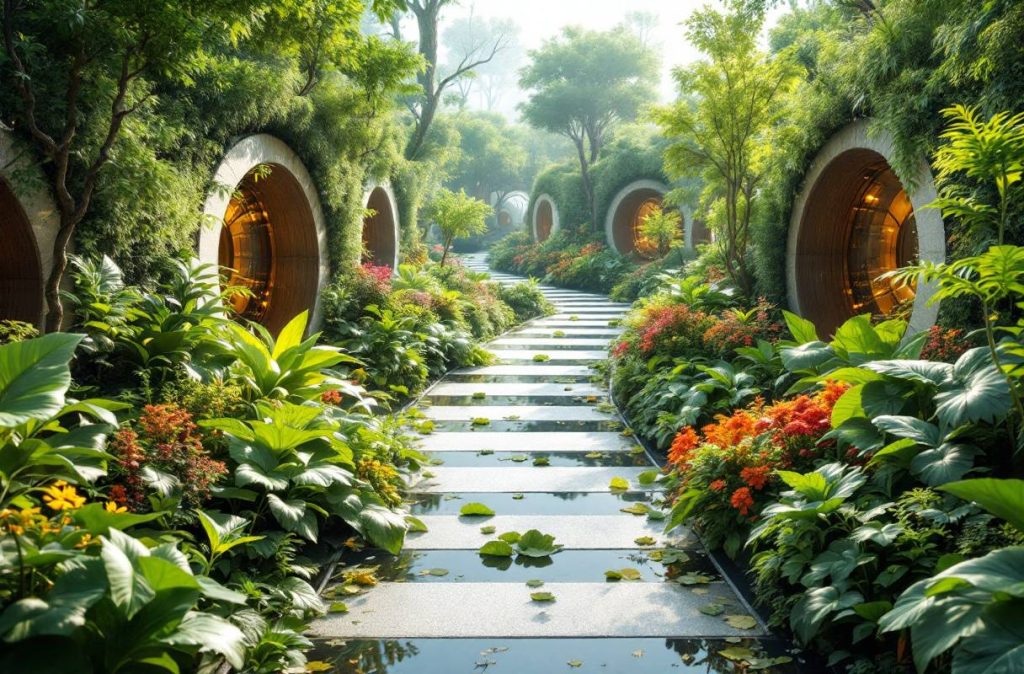Imagine a world where our technology seamlessly blends with nature, harnessing billions of years of evolutionary genius to create sustainable solutions. This isn’t a scene from a sci-fi movie—it’s the innovative realm of biomimicry in sustainable tech.
By emulating nature’s time-tested strategies, we’re not just building smarter gadgets; we’re paving the way for a greener, more resilient future.
Dive into how borrowing Mother Nature’s blueprints is revolutionizing the way we approach technology and sustainability.
Introduction to Biomimicry in Sustainable Tech
Definition of Biomimicry
Biomimicry is all about copying nature’s fancy tricks to tackle human challenges. Picture this: borrowing Mother Nature’s blueprints that took billions of years to polish. The idea comes from the Greek words ‘bios’ for life and ‘mimesis’ for mimic. It’s about using nature’s knack for survival to create human solutions that are a whole lot friendlier to the planet.
In the world of sustainable tech, biomimicry is like the difference between plowing through resources and treading lightly. Old-school methods may suck the earth dry, but biomimicry’s mission is to craft stuff that’s as beneficial as it is green.
Importance of Integrating Nature into Technology
Why’s it such a big deal to blend nature’s wisdom into our gadgets and gizmos? Because it holds the key to Earth-friendly and efficient innovations. Let’s break down why biomimicry matters for flipping the sustainable tech game:
Resource Efficiency
Nature’s a genius at getting the most bang for its buck, squeezing out top-notch functionality with minimal energy and materials. By mirroring these strategies, tech can be built to sip resources instead of guzzling them, yet stopping short of performance. Like how figuring out leaf structures helped solar panels soak up sunlight way better.
Waste Reduction
In nature, one guy’s trash is genuinely another’s treasure. Nothing gets wasted—everything serves a purpose. By adopting this zero-waste mindset, we can slay waste in both factories and households. So, taking a leaf from nature’s book means better e-waste management and giving the circular economy a fighting chance.

Material Innovation
Nature’s arsenal includes nifty materials—think super strong, feather-light, and fits-in-the-earth seamless. Biomimicry can light up new ideas for building materials and bioplastics, keeping us from overusing non-renewable resources and causing Mother Earth less grief.

Environmental Impact
Tech inspired by biomimicry has a smaller eco-shadow compared to old, clunky systems. By thinking like nature, we can craft gadgets that dance in tune with the environment, dodging problems like pollution and habitat wreckage. This nature-first path aligns with bigger eco-friendly missions like slashing carbon emissions and safeguarding wildlife.

| Benefit of Biomimicry | Tech Twists Examples |
|---|---|
| Resource Efficiency | Solar panels like leaves |
| Waste Reduction | Loop-tight recycling systems |
| Material Innovation | Nature-based biodegradable materials |
| Environmental Impact | Low-carbon tech modeled after nature |
Get the scoop on biomimicry’s role in reshaping sustainable tech with our reads on renewable energy basics and eco-friendly packaging solutions.
Tapping into biomimicry is more than just hugging trees and saving the planet. It sparks economic perks, fuels creativity, and delivers industry-transforming answers. As such tech sharpens, it could revamp realms such as smart grid wonders, with-it computing practices, and even next-gen eco-friendly fashion.
When we get into the groove of nature-based design principles with biomimicry, we unlock a world of Earth-smart tech that vibes with our planet, paving the way for a lasting and bright greener tomorrow.
Biomimicry Principles
Biomimicry in sustainable tech is all about taking notes from Mother Nature’s playbook, where everything just clicks together. By borrowing these seasoned designs and processes, creators can whip up inventions that aren’t just smart but also buddy up with the planet.
Learning from Nature’s Designs
When it comes to nature’s blueprint, it’s all about watching and cracking the code behind what makes Mother Nature tick. She’s had billions of years to get it right thanks to evolution. By copying these patterns, earth-friendly tech can tackle big problems without making a mess.
Nature’s got loads of tricks up its sleeve:
- Leaf Structures: Solar panels channel that sun-catching magic seen in leaves, cranking up sunlight absorption. Curious? Check out renewable energy basics.
- Animal Adaptations: Take geckos with their sticky toes—they’ve sparked breakthroughs in adhesives, giving material science a nifty twist.
Adapting Nature’s Processes
Adapting from nature isn’t just parroting the designs but also getting on board with the processes that make them work. It’s about wrapping our heads around the science and using it in tech and business practices.
Nature loves a loop:
- Waste-Free Systems: In a forest, one critter’s trash is another’s treasure. This can birth zero-waste approaches in industry, nodding to the circular economy technology.
- Self-regulation: Ecosystems are masters at keeping their cool. Borrowing this can help build smart energy saving devices that vibe with usage and save juice.
Here’s a quick rundown of learning from nature’s designs versus adapting nature’s processes:
| Biomimicry Tactic | Example in Nature | Tech Translation |
|---|---|---|
| Nature’s Designs | Leaf structures | Solar panels |
| Nature’s Designs | Gecko feet | Adhesive stuff |
| Nature’s Processes | Forest life cycles | No-waste industry patterns |
| Nature’s Processes | Eco self-control | Smart power savers |
Both playbooks—clueing into designs and rolling with processes—are key to pushing green tech forward. Tuning into these strategies gives birth to ground-breaking answers to nature’s head-scratchers. Examples of this are popping up in eco-friendly building materials green computing practices, and heaps more.
Applications of Biomimicry in Sustainable Technology
Biomimicry, which means learning from nature’s greatest ideas, is a game-changer when it comes to making our world more sustainable. It’s like borrowing Mother Earth’s clever tricks to create new and better technologies in areas like energy use, cutting down waste, and inventing cool new materials.
Energy Efficiency
Using energy without wasting it is a top benefit of looking at nature. By observing how the natural world handles energy, engineers are crafting super-smart tech. Take termite mounds, for example. These little architects build structures that naturally maintain comfy temperatures, inspiring designs for buildings that do the same.
| Nature’s Design | Biomimetic Application | Energy Savings |
|---|---|---|
| Termite Mounds | Building Temperature Control | Save up to 30% |
| Whale Fins | Wind Turbine Blade Shape | Boost up to 20% |
| Photosynthesis in Plants | Solar Panels | 10-15% better performance |
Learn more about how renewable tech is changing the game in our article on renewable energy basics.
Waste Reduction
In nature, waste isn’t wasted. Every bit of what an organism throws out gets used by something else. This neat trick can inspire us to cut down on trash in our industries. We can design systems where waste isn’t really waste, just starting points for something new.
A shining example is how fungi break down nasty pollutants in a process known as mycoremediation. These little guys can munch through all sorts of toxic stuff, making them perfect for cleaning up our planet.
| Biological Process | Biomimetic Solution | Impact |
|---|---|---|
| Mycoremediation (Fungi) | Pollution Busting | Cuts down gunk in soil and water |
| Earthworms’ Tummies | Composting | Boosts soil richness |
| Coral Reefs | Water Cleaning Systems | Better water quality |
Discover how we tackle e-waste with creative ideas in our article on e-waste management solutions.
Materials Innovation
Nature makes some incredible stuff that’s strong, light and lasts. Copying these natural wonders can revolutionize industries with products that hold up and play nicely with the environment.
Spider silk, for example, is pushing scientists to spin up super tough, stretchy materials for everything from stitches to armor. Likewise, the protective structure of mollusk shells has led to the design of materials that can resist heavy impacts.
| Nature’s Material | Biomimetic Product | Applications |
|---|---|---|
| Spider Silk | Super-Strong Fibers | Sewing up cuts, making clothes |
| Mollusk Shells | Impact-Resistant Stuff | Safety gear, building |
| Lotus Leaves | Waterproof Coatings | Clothes, construction |
See how nature inspires green buildings in our article on eco-friendly building materials.
By tapping into the secrets of biomimicry, technology becomes a friend to the planet, saving energy, cutting waste, and creating innovative materials. This blend of nature and smart thinking isn’t just cool—it’s essential for a cleaner, greener future.
Case Studies of Biomimicry Success
The magical world of nature has inspired countless cool gadgets and gizmos through a little trick called biomimicry. Let’s jump into three standout creations that took a cue from Mother Earth: Velcro, zippy bullet trains, and materials that patch themselves up like a scraped knee.
Velcro Inspired by Burrs
Velcro is like the rockstar of biomimicry, no joke. This nifty fastener drew its idea from the burdock plant, those irritating burrs that cling to your clothes and your dog’s fur like they own the place. Velcro’s two-part hook-and-loop design is ingeniously simple and effective.
| What It Does | Burrs (Burdock Plant) | Velcro |
|---|---|---|
| Sticking Style | Hooks latch onto fur or fabric | Hooks and loops grab on |
| Toughness | Stubbornly durable | Super tough synthetic |
| How You Use It | Nature’s hitchhiker | Snap on, off you go! |
Velcro proves that if you’ve got a problem, maybe Mother Nature already solved it. Wanna see more nature-fueled material wonders? Check out eco-friendly building materials.
Bullet Trains Mimicking Kingfishers
High-speed trains took a big leap forward by studying the kingfisher—a little birdie that can dive bomb into the water without causing a ruckus. Trains were making a racket exiting tunnels, so engineers copying the shape of this bird’s beak notched down the noise.
| What It Does | Kingfisher Beak | Bullet Train Nose |
|---|---|---|
| Looks Like | Sleek and pointy | Aerodynamic and pointier |
| Why It Rocks | Quiet splash catches fish easy | Less noise, more speed |
| Eco Boost | Nature’s perfect design | Better on gas and uber fast |
Thanks to this birdie-inspired tweak, tricks of the trade save on fuel and speed things up. Wanna geek out more on energy-wise gadgets? Visit smart energy saving devices.
Self-Healing Materials Modeled after Skin
Think about your skin’s superpower to heal itself (mostly) after you’ve gone and cut yourself. This clever ability inspired materials that do the same thing—mend breaks all on their own, making stuff last longer and waste less.
| What It Does | Human Skin | Self-Healing Materials |
|---|---|---|
| Healing Magic | Grows cells to fix you up | Chemical magic or tiny capsules that let loose the ‘fixer’ |
| Purpose | Shield your body, stay together | Fix breaks, last longer |
| Where It Works | Your body | Anywhere from buildings to gadgets |
Self-healing materials are pushing the waste-friendly envelope, proving nature really knows best. Wanna see more tech acing waste-busting? Click on e-waste management solutions.
As these examples show, biomimicry is the ticket to groundbreaking tech that doesn’t just solve today’s problems but also paves the way for tomorrow’s innovations. Mother Nature’s playbook is full of lessons begging to be borrowed!
Benefits of Biomimicry in Sustainable Tech
Environmental Impact
Biomimicry is all about cutting down on our carbon footprint by using nature’s playbook. Picture this: we’re taking cues from the plant world on energy savings and learning from critters about saving water. It’s helped us whip up some nifty green tech. Take vertical farming technology for instance—it’s like a forest’s got land use covered and hardly drinks up resources.
Loads of research backs up how biomimicry brightens up our environmental efforts, like these snaps:
| Benefit | Example |
|---|---|
| Energy Savings | Buildings smart enough to keep you comfy without cranking the heat or AC. |
| Waste Reduction | Systems that sort trash like a nature pro. |
| Resource Conservation | Water management that doesn’t need a magic wand. |
Economic Advantages
Biomimicry’s no slouch when it comes to saving a buck while doing good for the Earth. When gadgets and gizmos are crafted with Mother Nature in mind, operations run smoother, pockets stay deeper. Cutting back on energy use, trimming waste, and lowering the need for raw stuff put businesses in the black. And let’s face it—having the “green” tag on marketing ain’t hurting the appeal, bringing in folks who care about the planet and investors with a conscience.
Here’s what we’re talking about:
| Advantage | Description |
|---|---|
| Cost Efficiency | Lower costs by working smarter, not harder, thanks to nature’s cheat sheet. |
| Market Differentiation | Standing out in the crowd with sustainable goodies. |
| Investment Opportunities | Drawing in the dollars with planet-positive tech. |
Innovation Potential
Biomimicry is like a fresh breeze in the tech world, shaking things up and pushing us toward fresh paths. By getting cozy with how nature’s solved problems over time, researchers are onto groundbreaking ideas faster than you can say “Eureka!” This means big leaps in areas from renewable energy to green computing practices.
Check out these sparks of genius:
| Field | Biomimetic Innovation |
|---|---|
| Renewable Energy | Solar panels borrowing a leaf from photosynthesis. |
| Manufacturing | Fix-it-yourself materials taking a cue from biology. |
| Agriculture | Pest control that uses nature’s own hit squad. |
Biomimicry’s got a load of perks—it’s greening up our planet, boosting wallets, and sparking new ideas. Catch the wave of these nature-inspired methods and you might just find yourself in a brighter, cleaner future.
Dive into more about eco-friendly building materials and circular economy technology to see biomimicry’s fingerprints all over sustainable tech.
Challenges and Bumps in the Road
Biomimicry is a game-changer for eco-friendly tech, but it’s not all rainbows and butterflies. A few hurdles need jumping for it to hit its stride.
Tech Hiccups
Getting tech to act like Mother Nature isn’t always a walk in the park. You need top-notch gadgets and skills, and not everyone’s got those lying around. Plus, trying to mimic nature’s crazy mechanisms often calls for fancy gear and folks who know their stuff, which can make your wallet feel lighter.
| What’s the Issue? | What’s the Deal? |
|---|---|
| Advanced Tech Toys | Need cutting-edge tools to play the game |
| Fancy Gear | Gotta splash out on some serious equipment |
| Brainy Folks | Need super-skilled people on the team |
Thinking About Right and Wrong
Copying nature’s genius sounds cool, but let’s not ruffle any feathers—or the environment’s balance. Ethical quandaries pop up when making sure that nature stays unharmed in this tech revolution. Concerns include where we get our bio-stuff, how it affects critters, and what the long-haul impact could be.
| Ethical Worry | What to Keep in Mind |
|---|---|
| Bio-Stuff Sourcing | Grab materials the eco-friendly way |
| Critter Impact | Keep habitats and critters safe and sound |
| Big Picture | Think about how this affects Mother Earth down the line |
Red Tape Roadblocks
Trying to fit biomimicry into existing laws is like squeezing into last year’s jeans. The legal world isn’t always up to speed with this new kind of tech. Getting through the bureaucratic maze can drag out the process and put the brakes on innovation.
| Hurdle | What’s the Hang-up? |
|---|---|
| Law Fitting | Old rules might not fit new tech |
| Playing by the Rules | Gotta juggle different international standards |
| Paperwork Parade | Slow and tangled approval hurdles |
These bumps emphasize why we need scientists, lawmakers, and industry bigwigs to team up. Address these hurdles, and biomimicry can really take off, driving us towards an eco-friendly future. If you’re curious about other green tech challenges, try our reads on e-waste handling and circular economy tools.
Future Trends in Biomimicry
Peering into future trends in biomimicry opens up some fascinating possibilities for the sustainable tech scene.
Teaming Up with Nature
The road ahead for biomimicry involves rolling up our sleeves and getting hands-on with Mother Nature herself. Scientists and engineers will need to buddy up with biologists and ecologists to really get the scoop on how natural systems work their magic. This kind of teamwork can spark ideas that are not just genius but also gentle on the planet.
You can already see this kind of collaboration buzzing in projects like vertical farming technology and water-saving technology, where we’re basically taking notes straight from nature’s playbook.
Evolution of Sustainable Practices
As technology marches on, so will the way we pull inspiration from nature. The game plan? Shift from just copying nature’s cool designs to actually figuring out and weaving in the processes and thrifty tricks found in nature. This could mean tech that’s not just sturdier but can roll with the punches as well.
| Area of Innovation | Nature-Inspired Trick | What’s Next? |
|---|---|---|
| Power Up | Photosynthesis | Solar energy upgrades |
| Trash Talk | Natural Decomposition | E-waste solutions |
| Build Better | Spider Silk | Eco-building materials |
Sneakin’ into Every Industry
The magic of biomimicry is set to touch all sorts of industries, making stuff that’s not just greener but also more kickass. From how we get around to how we grow our grub and even how our computers think, biomimetic strategies are making their way.
- Transportation: Look out for vehicles and roads taking cues from birds and fish to cut down on drag and emissions. Future green transportation
- Agriculture: Crops and critters will get a boost from natural pest tricks and tough-as-nails plant designs, making the global food chain tougher and more sustainable. Vertical farming technology
- Computing: Brain-borrowed algorithms will make our computers smarter and leaner, pushing the envelope in green computing practices.
Pooling our smarts, tweaking how we keep things sustainable, and letting biomimicry sneak into all industries will cement it as the go-to for tech that clicks with nature. We’re talking about syncing up human know-how with the wisdom of the wild.
Conclusion
As we’ve journeyed through the ingenious world of biomimicry, it’s clear that nature holds the key to sustainable technological advancements. From energy-efficient designs inspired by termite mounds to waste-reducing systems modeled after forest ecosystems, biomimicry offers practical and eco-friendly solutions to today’s pressing challenges.
By embracing nature’s wisdom, we not only enhance resource efficiency and material innovation but also significantly reduce our environmental impact. The future of sustainable tech lies in this harmonious blend of human ingenuity and natural brilliance, ensuring a thriving planet for generations to come.
Let’s continue to learn from and collaborate with nature, forging a path toward a truly sustainable and innovative tomorrow.
Frequently Asked Questions (FAQs)
What is biomimicry in sustainable technology?
Biomimicry in sustainable technology involves designing products and systems inspired by nature’s models, processes, and elements to create eco-friendly and efficient solutions.
How does biomimicry improve resource efficiency?
By emulating nature’s optimized use of materials and energy, biomimicry helps develop technologies that require fewer resources while maintaining high performance.
Can biomimicry reduce industrial waste?
Yes, biomimicry promotes zero-waste systems by designing processes where waste is minimized or repurposed, similar to natural ecosystems.
What are some examples of biomimicry in technology?
Examples include Velcro inspired by burrs, bullet trains modeled after kingfishers, and self-healing materials based on human skin.
What challenges does biomimicry face in sustainable tech development?
Challenges include the need for advanced technology and expertise, ethical considerations in sourcing natural materials, and navigating regulatory frameworks.
How does biomimicry contribute to economic advantages?
It reduces costs through efficient resource use, differentiates products in the market, and attracts eco-conscious investors and consumers.
What future trends are emerging in biomimicry for sustainable tech?
Trends include increased collaboration with natural scientists, the evolution of sustainable practices beyond design to processes, and the integration of biomimetic strategies across various industries.
Additional Resources and Authority References
- Biomimicry Institute: Leading organization promoting biomimicry practices.
- Harvard’s Biomimicry Resource: Academic perspectives on biomimicry in technology.



















